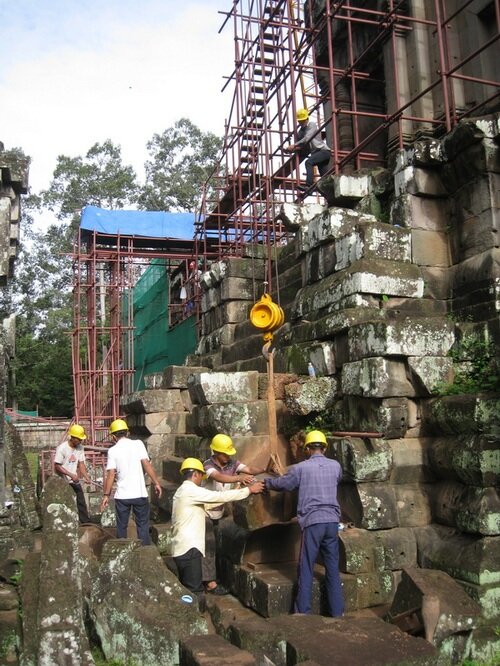The Chau Say Tevoda and Ta Keo Restoration Projects
Two major restoration projects in Angkor Thom led by the Chinese Academy of Cultural Heritage (CACH)

- Published
- November 16th, 2012
- Pages
- 1
- Languages
- English, Chinese
Officially launched on March 29, 2000, the conservation project for Chau Say Tevoda and Ta Keo Temples supervised by APSARA Authority lasted ten years, from 1998 to 2008, and is still ongoing at Ta Keo. Specialists from the Chinese Academy of Cultural Heritage (CACH) had to recover more than 4,000 stones and stone fragments scattered around the area, sometime using newly-cut blocks as replacement, a technique that has been criticized at the time but was deemed necessary due to the deterioration of the sites.
The temple of Thomannon nearby had been restored in the 1960s by the EFEO teams under Bernard-Philippe Groslier’s direction.
About CACH
Liu Hanxing, CACH Associate Researcher, presents the academy to Angkor Database users: “CACH is a scientific and technological research institution for cultural heritage protection directly under the State Administration of Cultural Heritage.
“Its predecessor can be traced back to the “Old Capital Cultural Relics Commission” established in 1935; it was renamed “Beijing Cultural Relics Commission” in 1949, and it was the first cultural relics protection professional organization sponsored and managed by the central government in New China;In 1973, it was renamed as “Institute of Science and Technology for Conservation of Cultural Relics”; in 1990, it merged with the Ancient Documents Research Office of the Ministry of Culture to form the Chinese Institute of Cultural Relics; in August 2007, it was renamed as Chinese Academy of Cultural Heritage.
“According to the requirements of the State Administration of Cultural Heritage, the current main responsibilities of the China Cultural Heritage Research Institute are: to carry out scientific research on cultural heritage development strategies, management systems, policies and regulations, discipline systems, and standardization systems; organize the implementation of China’s world cultural heritage sites and preparations List dynamic information and early warning and monitoring system construction, and carry out research on the protection and management of world cultural heritage; carry out the survey, design, planning, protection, construction, and supervision of immovable cultural relics represented by key national cultural relics protection units; undertake national cultural relics protection foreign aid projects; carry out cultural relics preservation surveys, cultural relics materials, cultural relics protection materials, etc. Carry out the design and organization of the restoration of cultural relics in the collection, organize the implementation and evaluation of their effects, carry out research on the application of traditional technology and modern technology in the protection of cultural relics, carry out industry qualification training, professional technical training, engineering special training and international cooperation training.
“According to preliminary statistics, the whole institute has undertaken and completed more than 500 cultural relics protection and maintenance design and construction projects (including more than 100 major projects), and more than 300 cultural relics protection technology projects (including more than 20 national-level projects).There are more than 20 national basic research research projects, more than 100 kinds of books have been published, and the projects undertaken have won many national, provincial and ministerial awards.
“In 1996, the State Administration of Cultural Heritage sent a working group to inspect the historical sites of Angkor. In 1997, the State Administration of Cultural Heritage selected ChauSayTevoda Temple as the object of protection, restoration and research, and commissioned the CACH to formally form the “Chinese Government Aid Task Force for the Protection of Angkor Historic Sites in Cambodia” to start the development. In the ChauSayTevoda Temple protection and restoration project, CACH has also become the first cultural and scientific research unit to go abroad to carry out cultural heritage protection and archaeological activities in the name of the Chinese government. In 1998, the protection, restoration and archeological research of ChauSayTevoda Temple was officially launched. This was the first cultural relics protection project implemented by the Chinese Academy of Cultural Heritage in Cambodia, and the first large-scale international protection of cultural relics and historic sites that the Chinese government participated in for the first time. As a cooperative project, the archaeology of ChauSayTevoda Temple has also become the first foreign archaeological work carried out on behalf of China in the Chinese archaeology circle. The project was completed as a whole in 2008.
“After that, CACH continued to repair and protect the Ta Keo temple in Angkor’s historic site from 2008 to 2018. In 2019, CACH began to protect and restore the palace site, and this work will continue until 2030.”
Photos: Ta Keo and Chau Say Tevoda sites (CACH)
Tags: Chinese research, Chinese contribution, Angkor Thom, heritage preservation, archaeology, Queen Mother Monineath


